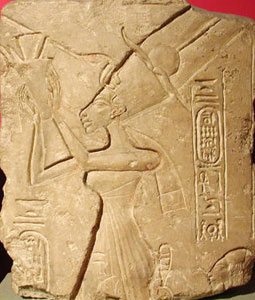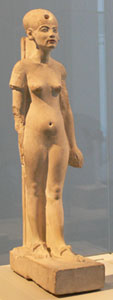Nefertiti generally wore a close fitting almost diaphanous sheath dress, but was also depicted naked. In part this related to her role in the fertility cult. During the early years of Akhenaten’s reign Nefertiti wore the crown of Hathor (cow horns and a sun disc, often including plumes) or the headdress of Mut (the vulture goddess).

When the royal family moved to Armarna, Nefertiti favoured a flat-topped version of the blue war crown which she is most often associated with. The famous bust of Nefertiti depicts her wearing this crown. The crown linked the queen with the goddess Tefnut, a solar deity. In this she emulated the role of “God’s Wife of Amun”, wearing the same close fitting robe tied with a red sash and Nubian wig with either a double uraei (royal cobra) or the double plumed crown with a sun disk. However, it may be that her power exceeded even that of Ahmose Nefertari (the foundress of the eighteenth dynasty and first to use the title “God’s Wife of Amun”).
Nefertiti’s Disappearance

Until recently it was thought that Nefertiti vanished around year twelve of Akhenaten’s reign. It had been suggested that she was disgraced and her place at the King’s side was taken by her daughter Merytaten and the lesser wife Kiya (possibly the mother of Smenkhare and Tutankhamun). According to some commentators, Nefertiti’s name was removed from inscriptions and replaced with that of Merytaten. However, others have suggested that it was Kiya’s name and images that were removed from monuments. Proponents of this view suggest that Nefertiti was jealous of Kiya because she had provided two sons for the king, and so she arranged for her disgrace. So far, no evidence has been recovered to support this highly speculative story.
It is also possible that Nefertiti simply died, and her death was so painful for Akhenaten that he did not wish to be reminded of her publicly after she had gone.
Other theories proposed that Smenkhare (the successor of Akhenaten) was the same person as Nefertiti and that she simply wore male garb when acting as co-regent with her husband. It is suggested that while she acted as co-regent, her role as queen consort was taken over by her eldest daughter, Merytaten. Proponents of this view point to the fact that Nefertiti and Smenkhare used the name “Neferneferuaten” (“the beautiful beauty of the Aten”), but the idea is not generally accepted.

Another theory is that there were actually two co-regents, consisting of a male son named Smenkhkare, and Nefertiti under the name Neferneferuaten, both of whom adopted the prenomen, Ankhkheperure. Akhenaten and Smenkhare were succeeded by Tutankhamun, and some writers have suggested that Nefertiti was still alive during the first couple of years of his reign. However, Aldred noted that the convention of placing the phrase maet kheru (justified or true of voice) after the name of a deceased person was abandoned during Akhenaten’s reign and re-instated shortly after his death.
In 2012, an inscription referring to “Great Royal Wife, His Beloved, Mistress of the Two Lands, Neferneferuaten Nefertiti” was found in a limestone quarry at Dayr Abu Hinnis north of Amarna (Akhetaten) dated “Regnal Year 16, month 3 of Akhet, day 15”. This would seem to confirm not only that Nefertiti was alive towards the end of the reign of Akhenaten (he ruled for seventeen years), but also that she was still his queen at that point and not his co-regent.
This, of course, does not preclude her from being the female Amarna pharaoh known as Neferneferuaten who may have ruled after the death of Akhenaten. This female pharaoh used the epithet “Effective for her husband” in one of her cartouches, suggesting she was either Nefertiti or her daughter Meritaten (who was married to king Smenkhkare).
Nefertiti rediscovered?
In 1898, the tomb of Amenhotep II was excavated and both the pharaoh and eleven other mummies (including the so called the “Elder Lady” and the “Younger Lady”) were also discovered in intact chambers. It is now generally thought the “Elder Lady” is Queen Tiye (mother of Akhenaten) but there has been much conjecture about the “Younger Lady”. Joann Fletcher has argued that the “Younger Lady” is Nefertiti and that she reigned as Smenkhare. The body had a shaved head but wore a Nubian wig (as did Nefertiti) and had a double piercing on each ear (which was fairly rare).
The face had been badly mutilated around the time of the burial, and an arm snapped off, but the fingers were still clasped in the position associated with a pharaoh holding a scepter. Archaeologists also discovered a number of “nefer” beads with the burial, items strongly associated with Nefertiti.
Other commentators have suggested that the deceased was too young to be Nefertiti (the body is thought to have been about 30 years old). More controversially, Zahi Hawass (Secretary-General of the Supreme Council of Antiquities) rejected the identification with a fairly personal attack on Fletcher (who he has now banned from working in Egypt), stating that the mummy is not even female! This is presumably based on the fact that the mummy’s arms are bent – usually associated with male burial, but possibly associated with the burial of a pharaoh.
Others reject the identification of Nefertiti while accepting that the body is indeed female, and suggest that it is a relative of Nefertiti rather than the lady herself. A recent CT scan led researchers to conclude that the body was female and may be Tutankhamun’s biological mother, an unnamed daughter of Amenhotep III and Queen Tiye, but not Nefertiti.
In 2015, Nicholas Reeves announced that high resolution scans of Tutankhamun’s tomb suggested there were “two previously unknown doorways, one set within a larger partition wall and both seemingly untouched since antiquity”. In 2022 hieroglyphs discovered in the tomb have given weight to his assertion. It is possible that her burial chamber will be discovered soon!
Bibliography
- Fletcher, Joann (2013) The Search For Nefertiti
- Van Dijk, Jacobus (2000) “The Amarna Period and later New Kingdom”, in The Oxford History of Ancient Egypt Ed I. Shaw
- Tyldesley, Joyce (1998) Nefertiti: Egypt’s Sun Queen
Copyright J Hill 2010